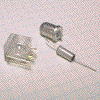|
|
BEAM Pieces is a BEAM Reference Library site.
State sensors
Getting a read on the state of
your BEAMbot
State sensors tell your 'bot something about its condition and local environment -- tilt, temperature, and the like. These can be used to change your 'bot's behavior in ways (ideally) that help it protect itself and get around.
Tilt switches 
![]() (1/4" grid)
(1/4" grid)
A number of types of tilt switches are commercially
available -- all use some sort of moving contact (in some
cases a blob of mercury, in others a metal ball) to short
out various contacts. You can use these to cause your 'bot
to do something special if...
Your BEAMbot has flipped "upside down"Your BEAMbot is on a "dangerous" slope, and needs to turn in order to avoid rolling
Your BEAMbot is attempting to climb up / down a slope that is beyond its capabilities, and needs to reverse
'Most any of these will work for you; personally, I try to avoid tilt switches containing mercury since it's toxic, and generally contained in glass vials that are fairly easy to accidentally break open.
 Thermistors
are the most common temperature sensors you'll run across --
they're just temperature-sensitive resistors (resistance
goes down as temperature goes up). The internal chemistry of
thermistors is quite tailorable -- this allows manufacturers
to make thermistors with a wide selection of temperature
sensing ranges.
Thermistors
are the most common temperature sensors you'll run across --
they're just temperature-sensitive resistors (resistance
goes down as temperature goes up). The internal chemistry of
thermistors is quite tailorable -- this allows manufacturers
to make thermistors with a wide selection of temperature
sensing ranges.
Note that thermistors tend to exhibit a fair amount of variability from unit to unit. So if you're using a pair of thermistors to give your 'bot the ability to find warm or cool areas, you'll want to incorporate a potentiometer to allow you to "tune" their response a bit (or else, buy a number of thermistors and attempt to find a "matching" pair).
AD-590s are temperature sensing integrated circuits which
output a current proportional to temperature. While more
expensive than thermistors
(about $5 US each, vs. a few cents for a thermistor),
they are also much more accurate. This allows you to
dispense with matching and tuning should you be using
temperature sensors as a "homing" device.
|
|
||
|
|
This page was last updated on |
|